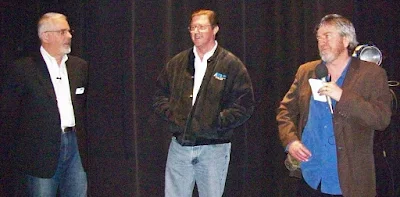 The Digital Cinema Society (DCS) hosted an exclusive preview of the latest ARRI technology including the next generation of ARRI digital cameras with a hands-on demonstration of the prototype code named ALEXA and their innovative post-production software, Relativity and new lighting fixtures such as the redesigned lens-less daylight 1.8K/1.2K watt HMI and the cooler and output efficient Ceramic 3200K 250 watts studio spotlight.
The Digital Cinema Society (DCS) hosted an exclusive preview of the latest ARRI technology including the next generation of ARRI digital cameras with a hands-on demonstration of the prototype code named ALEXA and their innovative post-production software, Relativity and new lighting fixtures such as the redesigned lens-less daylight 1.8K/1.2K watt HMI and the cooler and output efficient Ceramic 3200K 250 watts studio spotlight. Showing above, the ARRI LoCaster LED fixture (left) features an easy to use onboard controller with a choice of six color temperature settings, continuous dimming and ON/OFF switch. Weighing 2 lbs it is an ideal companion for mobile applications. To the right shown, is the Studio Ceramic 250. User benefits include lamp performance equal to a 1kW halogen lamp, cooler housing temperatures, low power consumption, long lamp life, hot restrike, integrated ballast, 3200K color temperature and a Color Rendering Index >90.
Showing above, the ARRI LoCaster LED fixture (left) features an easy to use onboard controller with a choice of six color temperature settings, continuous dimming and ON/OFF switch. Weighing 2 lbs it is an ideal companion for mobile applications. To the right shown, is the Studio Ceramic 250. User benefits include lamp performance equal to a 1kW halogen lamp, cooler housing temperatures, low power consumption, long lamp life, hot restrike, integrated ballast, 3200K color temperature and a Color Rendering Index >90.The first presentation of the evening was by Mike Jones, Lighting Division Representative, who introduced some of the TrueBlue line of studio fresnels, the new Broadcaster and Lowcaster handy LED fixtures, the 1.8/1.2K watt daylight HMI with a redesigned lens-less reflector and housing, capable of being plugged into a 20Amp household circuit and the ARRI Studio Ceramic 250 Spotlight, to a mixed and eager audience of cinematographers, camera operators, producers, directors and film school students.
 Three cinematographers framed in an animated conversation,
Three cinematographers framed in an animated conversation,John Newby ASC, Bonnie Blake, SOC & Dianne Farrington, SOC
The Alexa prototype is designed around the AlevIII CMOS sensor, offering an unsurpassed sensitivity and dynamic range at 800 ASA plus offering more tha n two stops faster than its popular predecessor, the reliable D-21 used by top cinematographers as their feature film camera set-up of choice.
The Alexa comes in three camera models with an estimated price range of $69.510 to $180.700 depending of the models. The two entry level models (A-EV/A-EV Plus) utilize a 16:9 area from the sensor and are complemented by the ARRI EVF, the most advanced electronic viewfinder on the market. The high-end model (A-OV-Plus) offers a 4:3 sensor and a rotating mirror shutter linked to an optical viewfinder, ready to support anamorphic PL mount lenses.
At the heart of the three models is the AlevIII sensor with a Bayer color filter array and optical low pass filter with a 800+ Exposure Index and a full 35mm frame size with a maximum usable area to support 4:3 anamorphic PL mount lenses or 16:9 aspect ratio with a 3.5K pixel count to provide optimum oversampling for HD Video and 2K DI. The frame rate of the three models runs from 1-60 fps.
Alexa also features several output signals and methods, including T-Link certified on-board recording options, including multiple live HD and Data Mode Stream to ARRIRAW files output supported by ARRIRAW Converter, Digital Vision Nucoda, DVS Clipster, Filmlight Baselight, Glue Tools, Iridas, Avid, and other participants to the ARRIRAW Partner Program. The ARRIRAW workflow is Windows and MacOS platform compatible, allowing the users to choose the best workflow to fit their post-production needs.
describing features of ARRI Relativity software
Attendees to the event "Everything ARRI"


Another component of the ARRI workflow package is the ARRI Relativity software, a powerful suite of post-production tools that offer versatile control to your workflow. Using sophisticated motion estimation and spatial-temporal image filtering, ARRI Relativity software offers Texture Control, (such as adding or subtracting grain), Film Simulation, and Space Time Converter (spatial resampling and frame rate conversion). ARRI Relativity™ software is powered by Pixel Strings™, developed and licensed from Cinnafilm. Arri Relativity allows users to alter images in ways that appear as though they were achieved in-camera. Digital images can take the look of film while film images can be selectively degrained; scenes filmed at particular frame rate can be expanded or contracted to other frame rates, giving to cinematographers a broader range of flexibility while in post-production.
For more information about events and workshops held by the DCS click here.
For more information about ARRI products click here.
Read here the past posting ARRIFLEX unveils Alexa.
Watch New Digital ARRI-ALEXA-IBC 2009 video ON-DEMAND Playlist above.



































































